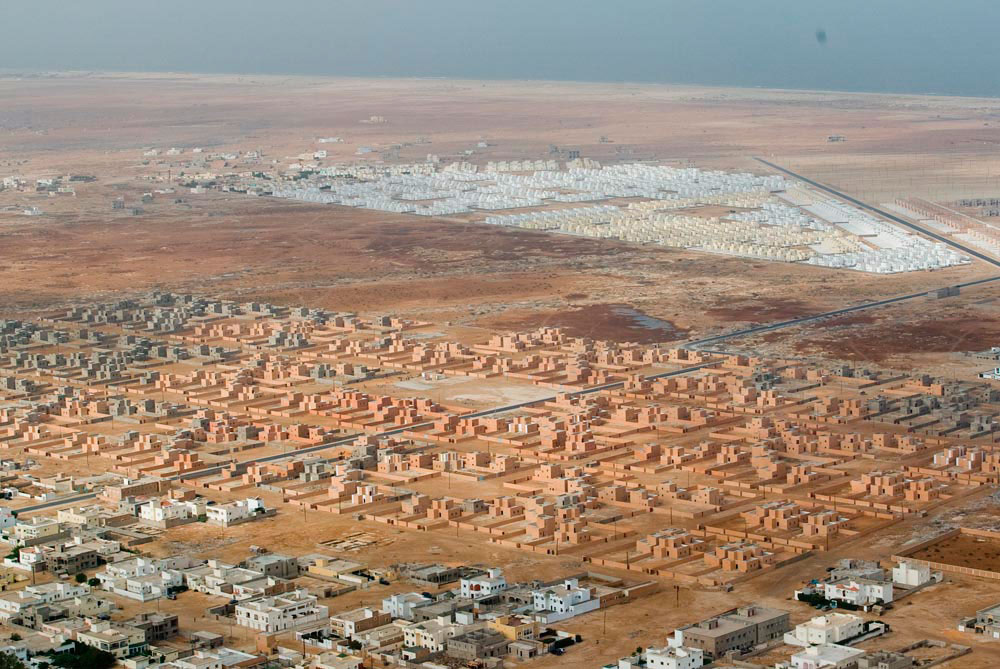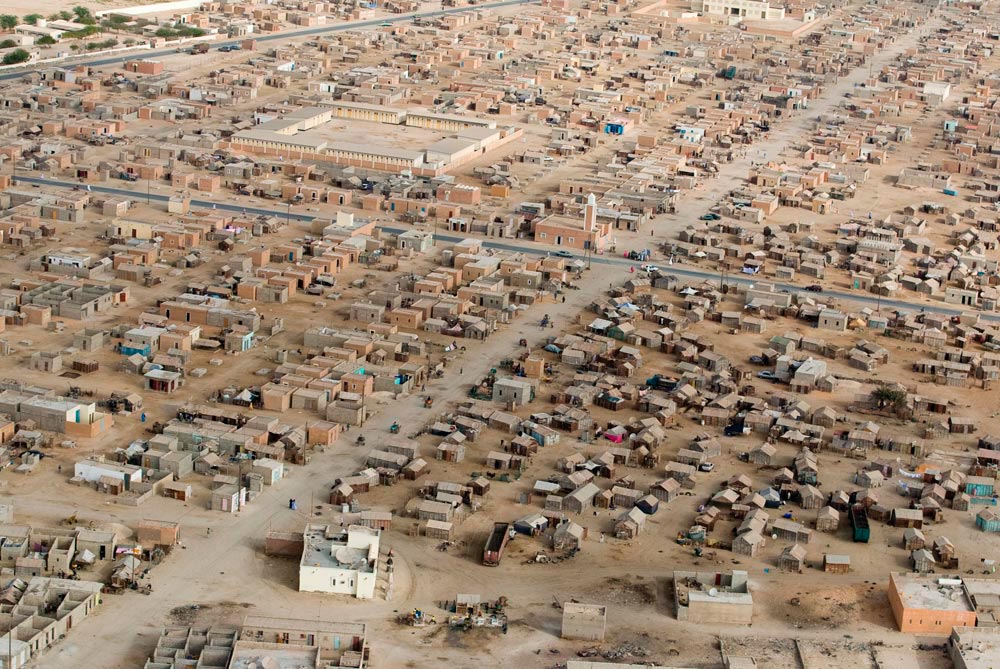The history of African cities is ancient. For instance, we know today that urbanisation in Africa existed long before Arab and Portuguese influences (Coquery-Vidrovitch, 1993). However, while this urban history is ancient, it is clear that Europeans introduced a new type of city based on grid patterns and ‘monumental’ architecture (Coquery-Vidrovitch, Georg, 1996). In the colonial era, the ‘real’ city was that of the whites (founded on the European economy), while ‘indigenous’ areas were not considered part of the city and tended to be identified with the village model (i.e. without rules). The importation of traditional village building techniques further reinforced this idea.
But beyond the relationship between the white and black city, this separation marked “the collective imagination, giving credence to the belief that ‘African culture’ (traditional, authentic, etc.) was that of the village” (Coquery-Vidrovitch, 1997). Thus, the African city only exists through the lens of European culture – or so recent works still tell us.
The metropolitanisation process of Third World countries is a form of urban development that is measured namely by urban sprawl, the development of large-scale agglomerations, and the formation of a hierarchical armature of cities at the global level (Bassand, 1997). The African continent is not an exception to this rule, with the emergence of ever larger, increasingly populated cities in a part of the world that, today, still has the highest population growth rates in the world (Schoumaker, 1999, Tabutin, Schoumaker, 2004). Hence, the African city should take its place in the network of globalised cities, in this de-territorialised universe of great metropolises.
However, “while immediacy and the virtual abolition of distances are the prerogative of London, New York and Hong Kong, what about cities like Douala or Lagos, where getting from one place to another can take hours and result in a series of transfers of unpredictable length?” (Malaquais, 2006). Of course African cities are growing at an impressive rate, becoming metropolises of several million inhabitants and competing at the international level. Of course forms are expanding, sprawl is spreading, and the urban fringes have not resembled the city in a long time, but rather consist of village-like areas. Of course Tv5 World and France 24 broadcast urban, metropolitan, white lifestyles in the remotest corners of Africa – in cities and in villages. In this way, African cities are global cities and are part of the international network of major cities.
But the likeness stops there. African cities are suffering economic crises, are largely in decline, have no industry, and remain on the sidelines of capital transfers that, lest we forget, largely define global cities (Sassen, 1991). Half of their population live in slums (Paquot, 1996, Davis, 2006) and have no access to water, electricity, mobility, or land. How, then, can it be said that Dubai, Tokyo, Karachi, Lausanne, Aix-en-Provence, or Buenos Aires are part of the same movement or follow the same model?
In the globalisation game (and it might ultimately be in this way that they are global), African cities are paying the heaviest price (Malaquais, 2006). Globalisation – synonymous with growing inequality – leaves hundreds of millions of people homeless in cities all over the global South.
However, the positive image that global cities and metropolises convey (at least in the literature) (Sassen, 1991, Bassand, 1997 Bassand et al., 2000b) stumbles over the reality of Yaounde and parts of Nairobi and Lagos, where the populations do not even have the remnants of globalisation: they are simply excluded, condemned to immobility, informality, and insecure tenure. And “for the vast majority of their inhabitants, both space and time are factors that are as real as can be. One could even say that, in some respects, their reality is accentuated by the multiplicity of images of distant places, [places] where most people living in Southern countries will never visit” (Malaquais, 2006).
Nevertheless, researchers continue to look at the African city through the lens of the European city model (Malaquais, 2006), which has important consequences not only for their research, but also for how it is used. Instead, it might be “better [to] think about the city in general, taking African cities as a starting point – the prototypes of a kind of global urban planning that is in gestation all over the world” (Malaquais, 2006) or, as Koolhaas argued in Mutations (Koolhaas, 2000), to demonstrate that the form of urbanisation found in Lagos is becoming a generic model.
Today, the cities of West Africa are facing a serious urban crisis, born of the imbalance created by large populations, urban sprawl, and limited financial means, all set against the backdrop of mounting environmental issues. Moreover, the little wealth that can be found there does not flow back to the people, so that in African cities today the vast majority of inhabitants live in precarious conditions in a specifically urban form: slums. The African city is structured by perpetual economic struggle, meaning that it does not expand as the result of economic growth but rather as a result of decline. “The history of global urbanisation that began in the mid-19th century goes hand in hand with shantytowns” (Paquot, 2006). This is the second aspect of the African city, which it likewise shares with other cities around the world. But slums – the precarious or spontaneous neighbourhood, as it is sometimes called – are becoming the sole development model of West African cities, in spite of the many investments, loans, and grants from the World Bank. The city nowadays is developing primarily via its informal fringes; hence, the importance of taking into account the dynamic expansion of the informal city in urban studies today.
Urban Planning in African Cities
One field in particular, urban planning, is working to guide the development of cities, attempting to understand the mechanisms present in the urban space and the mechanisms of the production of space through research. It is also responsible for rendering the results of these studies operational; in other words, giving the city the tools necessary for its development and daily management.
For cities, we generally distinguish urban policies, which provide a general framework (i.e. a way of thinking about the urban) for planning and management. If policies are the backbone, planning offers a long-term vision of the city, and management implements this planning. They are the three phases of a single process.
Current urban planning is based on plans and projects for infrastructure and facilities, usually in the form of a master plan (for the purposes of this book, we do not distinguish between master plans and blueprints, as both ultimately have the same purpose) and series of projects brought together in what are called a Priority Investment Program (PIP). However, while these approaches may work in smaller cities where spatial development is limited, this type of planning has poor or no results (when it is not outright counterproductive) in large cities.
Urban management is the implementation of urban planning. However, a range of different types of plans at different levels with no steering body is not enough (Massiah, Tribillon, 1988). In other words, ‘good’ urban policy is useless if an apparatus for implementing it has not been envisaged. Thus, management is the daily application of planning and policy.
These three elements – policy, planning, and management – have an influence on public space. Private management of water, as in certain parts in South America, can stop many urban neighbourhoods from developing: whole areas can remain untouched because a concessionaire chooses to not make investments for poor people.
Urban planning in contemporary African cities is a bit like SimCity, a videogame wherein the player creates and manages a city. Its likeness lies in the fact that, in both cases, anything and everything is possible. Recipes for a ‘good city’ are simplistic: give people roads, do not build industrial areas alongside residential ones, and presto! While Northern countries work on processes, governance, participation, and other power games, the South is still planning its cities à la Haussmann – at least this is the case in French-speaking West Africa. In this poorly adapted, French-style urban planning, it is often the beauty of the line that guides the process, with the underlying (and persistent) idea that a beautiful city plan makes for a beautiful city. It is here that planning joins forces with the urban imaginary.
Urban planning in African cities uses architectural methods. In other words, it is based on a plan to which a series of recommendations (sometimes called ‘specifications’ or ‘rules of construction’) that make up the corpus of urban development legal procedures is added. This type of planning allows planners to design the city’s image ‘as it should be’ (Massiah, Tribillon, 1988), at both the formal and the institutional levels, resulting in a comprehensive, coherent system of implementation procedures (Massiah, Tribillon, 1988) to which municipal works can be added. Planners do not want to reintroduce regulatory planning; rather, they wish to develop a simplified tool that will indicate the location of key infrastructure for future urbanisation purposes (Farvaque-Vitrovic Godin, 1997). These authors outline the Urban Reference Plan as a possible solution (PUR).
Urban planning is not in fashion. The limited impact of the documents that governed it in the past (blueprints and urban development plans) and around which considerable energy and investment were mobilized raised doubts as to their validity, especially as urban sprawl continues virtually unchecked and because limited public budgets make funding intervention difficult (Farvaque-Vitrovic Godin, 1997). However, urban planning is still necessary to guide the coordination of public and private intervention, both in the provision of services and facilities in older neighbourhoods and in the development of extension areas (Farvaque-Vitrovic Godin, 1997).
Planning work is an assessment of urban dynamics from three different angles (Tribillon, 2002): socio-demographic (population growth and social changes), economic (changes in activities and jobs in particular), and spatial (forms of land tenure). And yet, it is this scheme that is not working, leaving some authors (and the majority of urban planners) to be allured by simplified plans. However, if we, like Tribillon (2002), consider that the role of urban development is to organise the projection of a social dynamic in space, then planning simply cannot ignore the city’s complexity.
Public Space in the City
It was in the early 1970s that the concept of ‘public space’ was created to give a name to those places where urban inhabitants cross paths and meet (Tomas, 2001), and likewise to describe the disappearance of this same public space (i.e. the street, squares, and other spaces). It was in this context of loss of spatiality that the term was born, as though it were a question of finding lost urbanity (Tomas, 2001). The proliferation of discourses on public space in fact masked a kind of evaporation of the material reality of space itself (White, 2001), which is to say that over the course of discussions, definitions, and redefinitions, the concept shifted from a spatial notion to a territorial one.
Thus was there a semantic shift from the beginning, with public space understood as the place of expression (Habermas, 1962) of the res publica, to that of a threshing floor forpopular opinion, to that of the principle of democratic debate, finally coming to symbolise the exchanging of ideas. Streets, television, cafés, the radio, and the Internet – everything becomes ‘public space’ on the same basis, provided that people can share (in the full sense of term) their considerations or experiences therein (White, 2001).
The design and architectural form of urban public space can be defined by the network of streets, alleys, boulevards (Bassand et al., 2001) punctuated here and there by squares and parks, thus irrigating neighbourhoods. This network of spaces theoretically is free of construction and subject to public law. The site location plays on the form of the space (slopes, sunlight, etc.), as well as on planning rules and their potpourri of aesthetic and functional constraints, which set the space in the frame of a construction period. The buildings that line these spaces (mostly private but with public use, such as restaurants, shops, and other services that sometimes spill over onto the street) play a vital role in the form of public space.
The urban context, or centrality, is the location and role of the space in the city. In other words, the same space is not identical and changes depending on location in an industrial zone, residential area, working-class neighbourhood, or wealthy district (i.e. it will be more or less private, accessible and/or visible, etc.). Moreover, every street bears the identity of its city, but, in turn, contributes to the development of this identity (Bassand et al., 2000a) – a back and forth game of scales. It is also cosmogonic in that it organises and prioritises the beliefs and spaces contained within the city: it is the place that defines the model and the model that enables the analysis of the place – a part that contains the whole.
The last element is that of uses in the broader sense not only of issues but also social practices. From this perspective, public spaces can be divided into five distinct, interdependent categories:
· Spaces of accessibility: public space must be understood in its double meaning as a spatial support for human mobility (the key characteristic for modern city dwellers, which implies not only walking but the use of other modes of transport) and for urban infrastructure and facilities. Thus, public space reflects the selective logics of access to water, energy, sanitation, transport, and urban services, and in certain places is characterised by lack, neglect, insecurity, and/or environmental vulnerability, thereby exacerbating problems of public health.
· Spaces of festivity and civil/civic use: demonstrations, parades, and sit-ins all take place in public space and are a form of direct appropriation – both material and symbolic – since, theoretically speaking, there is transgression, as all public demonstrations are subject to government authorisation (Lafarge, 1996). This is where one affirms one’s place in civil society, where power changes hands, and silent marches (sometimes) overturn dictatorships. As for festivities, these serve to strengthen or awaken a sense of national belonging or, conversely, to elicit demonstrations of anger and/or protest (Lafarge, 1996).
· Commercial spaces: Due to internal structural constraints, debt burden, and relationships of economic dependency and domination with industrialised countries, the modern economy of Southern countries is unable to absorb all of the employment demand. This results in the development of informal economies, unemployment, and underemployment. Public space then becomes the place of urban economic exchanges, linking two parallel but interdependent circuits. More specifically, it assembles so-called informal activities, procurement relationships, and the production and marketing of goods and services. The informal economy – underground and sometimes illegal – promotes symbiotic relationships that are most easily identified at the local level, encouraging processes of specialization and professional sexualisation. Because its activities tend to have low entry barriers, it facilitates the economic integration of those struggling daily against poverty.
· Spaces of sociability: public space supports the internal (centred on the home) and external (orientated towards others and social relationships) sociability of a society. This sociability is organised in the form of networks that function according to the logics of solidarity or, conversely, dependency and submission. As part of a dynamic in permanent reconfiguration, these networks reproduce family, neighbourhood, generational, regional, ethnic, religious, and even professional affiliations. Relationships of sociability can also become institutionalised in the form of associations, or different types of interest groups (politics, leisure, sports, culture, etc.). These networks of sociability contribute to the survival of the most underprivileged through various forms of economic redistribution, although the relationships are unequal.
· Spaces of identity: as the privileged locus of socialisation, public space is also where urban identity is forged. Reflecting fast-paced cultural changes, it acts as a kind of interface, where traditional models of heritage and vectors of modernisation (the foundations of a globalised culture of progress) join up, clash, and combine. These modernist values highlight an individualistic concept of society (individualisation and atomisation), as well as specific conceptions of the organisation of economic (liberalisation), political (democratisation), and religious (secularism) realms, with a view to rationalisation, efficiency and productivity. To globalised hypermodernity and the living traces of a vernacular (based on mechanisms of métissage) can be added the constant tinkering and diversion tactics of poverty and precariousness. Identity processes in the urban milieu, therefore, also reflect the logic of relationships between rich and poor, dominator and dominated, as well as the disparate habits and conditions of unequal lives (Dris, 1999).
In short, public space is becoming increasingly ambivalent; it no longer has one unique role in the city, but rather can have several functions simultaneously depending on the season, the time of day, and, above all, the person observing and using the space.
This way of imagining public space is based on the presupposition of its specific value in the founding myth of the city. It is the major venue of expression of urban life, the collective space of daily democracy, like the Athenian Agora – a space void of individual property, a space of public and symbolic exercises of democratic power. In far away and exotic Athens, freedom of speech was nonetheless reserved for citizens, thus excluding women, slaves, and foreigners from the “power of cities” .
Public Space and the African City
The definition of public space we have chosen for our research is that of urban space outside of the home and the workplace (Couret, 1997). This (albeit partial) definition undoubtedly does not take into account all situations, but it is sufficiently clear and concise to be used in the African context.
As a support for networks and social practices and the product of modes of construction, development, management, and urban planning, public space in Africa is a place of exchange, debate, and negotiation between actors. It is also a great indicator of urban changes (PlanUrbain, 1988, PlanUrbain, 1991) and the privileged place of observation of social relationships in the urban milieu (Couret, 1997). In the case of West African cities, this angle is even more interesting, as the notion of public space is linked to the city’s social history, which is marked by the Western conception of public space (squares, markets, streets, avenues, stations, ports, etc.) redefined by indigenous uses. As such, these changes result in an altered urbanity, with renewed forms of sociability, economic exchanges, citizenship, accessibility, and identity. Given the globalised mechanisms of dependence that reinforce processes of exclusion, it is clear that the role of public space – the forum for integration and socialisation – evolves on a daily basis. Through this, it reveals changes that affect all societal spheres: social, cultural, political, spatial, and environmental.
On the one hand, these changes have largely been induced by the emergence of a global urban culture that tends to establish a unique global model by imposing a hegemonic form of urbanisation (the city) – a support for liberalisation and globalisation of the economy, but also of an increasing waste of resources, energy, and space. On the other hand, the largest cities in West Africa are also the product of a cultural reality, a non-Western system based on specific population, social, and economic dynamics, the permanency of traditionalist power and the resistance of these same forces. This battle between the local and the global that is still raging today is reflected in the complex tangles of acculturation, cultural resistance, and mestizo logic (Amselle, 1990) that influence patterns of construction, development, and the management of urban space.
Today, African public space must face the growing effects of globalisation, reflected by an increase in exclusion phenomena and the acceleration of vectors of modernisation (Bertrand, 1998). In West African cities, these urban changes can take various forms. As an extension of the domestic sphere, public space can reveal the breakdown of family and generational structures, the destruction of networks of solidarity and dependence, the conversion of professional activities, and the evolution of women’s roles in African society.
At the neighbourhood level, it can be the support for the institutionalisation of new sociability and territorial practices, as well as for the strategic reorganisation of interest groups no longer according to ethnicity or caste, but rather based on economic relationships of survival.















